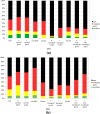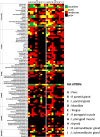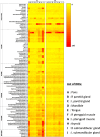Acquisition repeatability of MRI radiomics features in the head and neck: a dual-3D-sequence multi-scan study
- PMID: 35359245
- PMCID: PMC8971276
- DOI: 10.1186/s42492-022-00106-3
Acquisition repeatability of MRI radiomics features in the head and neck: a dual-3D-sequence multi-scan study
Abstract
Radiomics has increasingly been investigated as a potential biomarker in quantitative imaging to facilitate personalized diagnosis and treatment of head and neck cancer (HNC), a group of malignancies associated with high heterogeneity. However, the feature reliability of radiomics is a major obstacle to its broad validity and generality in application to the highly heterogeneous head and neck (HN) tissues. In particular, feature repeatability of radiomics in magnetic resonance imaging (MRI) acquisition, which is considered a crucial confounding factor of radiomics feature reliability, is still sparsely investigated. This study prospectively investigated the acquisition repeatability of 93 MRI radiomics features in ten HN tissues of 15 healthy volunteers, aiming for potential magnetic resonance-guided radiotherapy (MRgRT) treatment of HNC. Each subject underwent four MRI acquisitions with MRgRT treatment position and immobilization using two pulse sequences of 3D T1-weighed turbo spin-echo and 3D T2-weighed turbo spin-echo on a 1.5 T MRI simulator. The repeatability of radiomics feature acquisition was evaluated in terms of the intraclass correlation coefficient (ICC), whereas within-subject acquisition variability was evaluated in terms of the coefficient of variation (CV). The results showed that MRI radiomics features exhibited heterogeneous acquisition variability and uncertainty dependent on feature types, tissues, and pulse sequences. Only a small fraction of features showed excellent acquisition repeatability (ICC > 0.9) and low within-subject variability. Multiple MRI scans improved the accuracy and confidence of the identification of reliable features concerning MRI acquisition compared to simple test-retest repeated scans. This study contributes to the literature on the reliability of radiomics features with respect to MRI acquisition and the selection of reliable radiomics features for use in modeling in future HNC MRgRT applications.
Keywords: Head and neck; Intraclass correlation coefficient; Magnetic resonance guided radiotherapy; Radiomics; Repeatability.
© 2022. The Author(s).
Conflict of interest statement
The authors declare that they have no competing interests.
Figures







Similar articles
-
Reliability of MRI radiomics features in MR-guided radiotherapy for prostate cancer: Repeatability, reproducibility, and within-subject agreement.Med Phys. 2021 Nov;48(11):6976-6986. doi: 10.1002/mp.15232. Epub 2021 Sep 25. Med Phys. 2021. PMID: 34562286
-
Quantitative assessment of acquisition imaging parameters on MRI radiomics features: a prospective anthropomorphic phantom study using a 3D-T2W-TSE sequence for MR-guided-radiotherapy.Quant Imaging Med Surg. 2021 May;11(5):1870-1887. doi: 10.21037/qims-20-865. Quant Imaging Med Surg. 2021. PMID: 33936971 Free PMC article.
-
Longitudinal acquisition repeatability of MRI radiomics features: An ACR MRI phantom study on two MRI scanners using a 3D T1W TSE sequence.Med Phys. 2021 Mar;48(3):1239-1249. doi: 10.1002/mp.14686. Epub 2021 Feb 2. Med Phys. 2021. PMID: 33370474
-
Radiomics feature reliability assessed by intraclass correlation coefficient: a systematic review.Quant Imaging Med Surg. 2021 Oct;11(10):4431-4460. doi: 10.21037/qims-21-86. Quant Imaging Med Surg. 2021. PMID: 34603997 Free PMC article. Review.
-
A narrative review of MRI acquisition for MR-guided-radiotherapy in prostate cancer.Quant Imaging Med Surg. 2022 Feb;12(2):1585-1607. doi: 10.21037/qims-21-697. Quant Imaging Med Surg. 2022. PMID: 35111651 Free PMC article. Review.
Cited by
-
Repeatability of computed tomography liver radiomic features in a nonhuman primate model of diet-induced steatosis.J Med Imaging (Bellingham). 2023 Nov;10(6):066004. doi: 10.1117/1.JMI.10.6.066004. Epub 2023 Dec 8. J Med Imaging (Bellingham). 2023. PMID: 38090646 Free PMC article.
-
Radiomics for Discrimination between Early-Stage Nasopharyngeal Carcinoma and Benign Hyperplasia with Stable Feature Selection on MRI.Cancers (Basel). 2022 Jul 14;14(14):3433. doi: 10.3390/cancers14143433. Cancers (Basel). 2022. PMID: 35884494 Free PMC article.
-
A Comprehensive Evaluation of Radiomic Features in Normal Brain Magnetic Resonance Imaging: Investigating Robustness and Region Variations.J Med Phys. 2024 Oct-Dec;49(4):608-622. doi: 10.4103/jmp.jmp_149_24. Epub 2024 Dec 18. J Med Phys. 2024. PMID: 39926136 Free PMC article.
-
Evaluation of the Reliability and the Performance of Magnetic Resonance Imaging Radiomics in the Presence of Randomly Generated Irrelevant Features for Prostate Cancer.Diagnostics (Basel). 2023 Dec 1;13(23):3580. doi: 10.3390/diagnostics13233580. Diagnostics (Basel). 2023. PMID: 38066821 Free PMC article.
-
Imaging Assessment of Radiation Therapy-Related Normal Tissue Injury in Children: A PENTEC Visionary Statement.Int J Radiat Oncol Biol Phys. 2024 Jun 1;119(2):669-680. doi: 10.1016/j.ijrobp.2024.03.006. Int J Radiat Oncol Biol Phys. 2024. PMID: 38760116 Free PMC article. Review.
References
LinkOut - more resources
Full Text Sources
